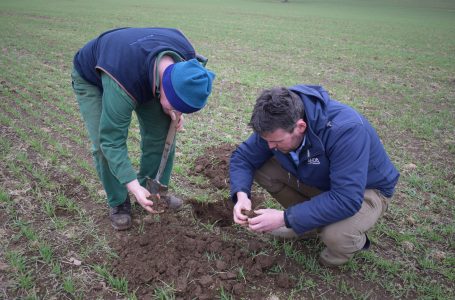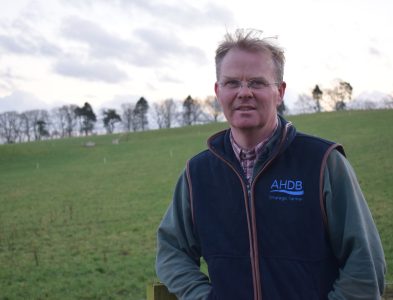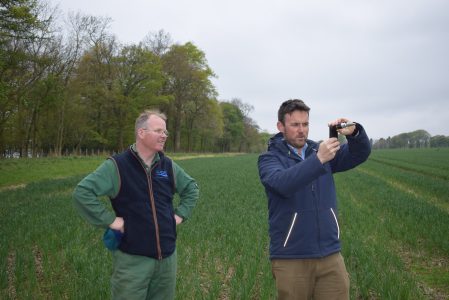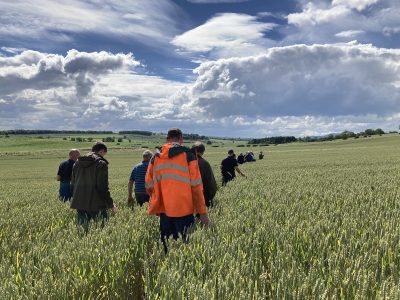
With costs rising and the effectiveness of some inputs waning, Farms Manager at Balbirnie Home Farms, David Aglen has been exploring different ways to improve crop yields with less reliance on artificial inputs over the last few years.
Interested in the approach of crop nutrition specialists such as Australian Graeme Sait and Canadian Joel Williams, who advocate a primarily nutritional and biological, rather than chemical, approach to growing crops, in 2015 he started trialling with direct drilling and cover cropping.
On a seven-year rotation, the farms, which cover 1200 hectares, grow mostly winter wheat and spring barley, as well as oats, winter barley, potatoes and carrots. The 200-head beef suckler herd has, as part of improving soil health, been moved on to a wholly outdoor grass-fed system, and is certified Pasture for Life.
In 2019, AHDB approached Balbirnie Farms to be a strategic partner for their farm-scale trials of regenerative techniques. With a growing interest in the industry in regenerative farming, AHDB were keen to experiment beyond small trial plots to see how different practices manifested in the scale and natural environment of real farm situations.
Over the last three years, the project has looked at reducing chemical inputs and improving plant nutrition through healthier soil with trials on cover cropping, direct drilling and bringing livestock back into the rotation to improve soil biology and structure, and applying nitrogen, an essential micronutrient, through leaves rather than roots.
Fiona Burnett, Professor of Applied Plant Pathology and Arable Technical Lead at SRUC, whose team is running the trials for the project and analysing the results, said:
“This is an example of when farming is ahead of the science. Farmers are changing their practices through need, under pressure from rising costs as well as a future agricultural policy strongly weighted towards soil health and carbon capture. Balbirnie, like many others, has already started making changes, and working with them like this we can bring the science and the practice together, to accelerate and benefit the progress of both for the whole industry.”
Field-scale science
The first two years as AHDB’s Strategic Cereal Farm Scotland were spent baselining and measuring the crops, soils and fields, agreeing initially how to best measure and monitor the changes. For biodiversity, one of the more complex measures, four control species were selected: two pests – aphids and slugs; and two beneficials: spiders and ground beetles.

Soil sampling
The AHDB and SRUC team are out on farm weekly to assess the trial areas, two spring barley crops and two wheat crops, testing the soil, counting plants, assessing cover crops and taking samples to analyse nutrient and disease levels.
“There are a lot of advances in regenerative farming across the world and evidence of plant nutrition working, but what works in Alberta doesn’t necessarily work on the East Coast of Scotland,” says David. “Working with AHDB and SRUC like this helps us with measuring and using ‘proper’ science to find what works in our climate and soils. There’s no way we could afford the time to be testing as regularly as SRUC is or the costs of lab analysis, so working in partnership like this is helping us progress quicker down the route we want to go down.”
Balbirnie Home Farms and AHDB host a summer open day for other farmers who are interested to find out more about it and see the work up close.
“They see the good, the bad and the ugly,” says David. “This is not just about us, it’s for farmers across Scotland to learn from as well. The more we work together to build a bigger picture, the faster we can all make progress.

David Aglen, Farms Manager
“We’ve learned a lot from the trials and changing practices. Some things have worked really well and we’ve also had some disasters. Although every farm is different, what the science finds as well as what is and isn’t working at a practical level will hopefully give other farmers insights into what might work on their own farms – and save them money and effort of some of the trial and error on the way! This approach is not for everyone, and the open days have been really good forums for discussion and debate.”
The good, the bad and the ugly
One aim of the trials is to find optimum sowing dates. This spring, Balbirnie Home Farms direct drilled the full 400 acres of spring barley on the back of positive results last year, drilling at the earliest date that the soil was dry enough (in 2023, this was the first week of April). The crop has emerged well so far.
Another is to move away from applying nutrition wholesale but giving it to the plants as needed. They have been trialling the use of foliar nitrogen, rather than putting nitrogen into the ground for uptake through the roots. Although the trial results in 2022 were not clear cut, David has felt confident enough to use the foliar method across all crops this season, reducing nitrogen use by 25%. So far in both cases, the crops look healthy and should yield well.
“It looks like if there is a good balance of nutrition in the crops, the less fungicide we need,” he says. “We have only used key fungicides on wheat crops this year, and they are currently looking better than those which have had more fungicide.”
The ingress of yellow rust is a challenge area they are working on.

Checking the Brix test meter
In the trials they sowed replicated plots of spring barley on three different dates, with three different treatments: no cover crop, cover crop burned off before drilling cover crop and cover crop burned off after drilling. The most benefit they could see, environmentally, was where the cover crop was left in longest where there is a trend this year for the organic matter to be higher. David’s recommendation is for the cover crop to be as “cheap as possible, and not get carried away with fancy mixes.”
The integration of livestock has given one of the most tangible uplifts. Large mobs of sheep are kept on small areas of the winter-sown arable fields for a short period, grazing enough to take the growth down but not too long as to decimate the root mass.
“Livestock is part of our toolbox of reducing the need for nitrogen and fungicide,” according to David. “It’s easy to tell where there hasn’t been livestock in the rotation as we need more chemicals to manage the crops.”
With the cattle outside year-round, it’s also reduced costs on concentrated feed and manpower on both bruising the feed and feeding indoors. Forage crops are grown to feed the cattle through the winter, which brings diversity into the rotation and reduces the disease pressure. However, it has been a learning curve. After the first very successful year of growing 35 acres of summer cover crops for the cattle, yielding 90 tonnes/ha, David boldly sowed 150 acres the following year in different fields, but it didn’t take and was a costly exercise.
What’s next
“By and large we are seeing it as a cheaper way to farm, with our variable costs potentially down by around £200/hectare,” says David. “The ground has been covered year-round now for four years and we are seeing more consistent crops, and the ground is drier so we can sow earlier. We may yield less, but it costs less. It’s definitely changed our farm policy – we now look at every decision through the regen lens.”
David yield maps which has helped enormously to assess the results. The advance of technology, such as hyperspectral cameras that identify signals of disease, deficiency and weeds could also play a significant role in efficient management but is still largely a research tool. We have taken drone images of the trial fields to overlay with the other detailed assessments we have.

Visiting the nutrition trials during the Strategic Cereal Farm Open Day
“Regenerative can be a fuzzy word that means different things to different people, but the aim of this research project is to explore ideas and practices and see what can improve productivity, whether it’s crops or livestock, and reduce costs, which is important to all farmers,” Fiona concludes. “This collaborative experimentation is vital as farmers like David bring the experience of practical farming and understanding of the context. We hope from our findings that other farmers will pick elements that work for them. What’s really important in the success of making any changes, is really knowing your own fields and crops and what will work for them.”
This case study was published as part of RHASS’ Presidential Initiative focusing on the science behind food production.